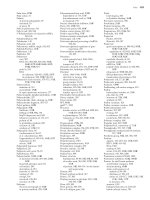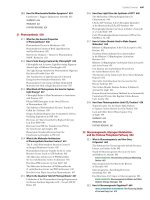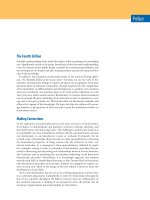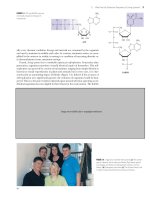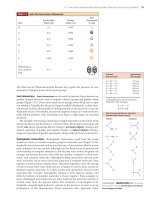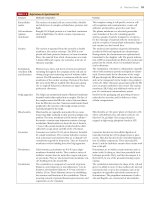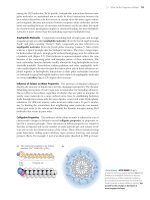Biochemistry, 4th Edition P83 doc
Bạn đang xem bản rút gọn của tài liệu. Xem và tải ngay bản đầy đủ của tài liệu tại đây (338.64 KB, 10 trang )
25.4 How Do Organisms Synthesize Amino Acids? 783
The ␣-Ketoglutarate Family of Amino Acids Includes Glu, Gln,
Pro, Arg, and Lys
Amino acids derived from ␣-ketoglutarate include glutamate (Glu), glutamine
(Gln), proline (Pro), arginine (Arg), and in fungi and protoctists such as Euglena,
lysine (Lys). The routes for Glu and Gln synthesis were described when we consid-
ered pathways of ammonium assimilation.
Proline is derived from glutamate via a series of four reactions involving
activation, then reduction, of the ␥-carboxyl group to an aldehyde (glutamate-
5-semialdehyde), which spontaneously cyclizes to yield the internal Schiff base,
⌬
1
-pyrroline-5-carboxylate (Figure 25.20). NADPH-dependent reduction of the pyrro-
line double bond gives proline.
Arginine biosynthesis involves enzymatic steps that are also part of the urea
cycle, a metabolic pathway that allows certain animals (including humans) to ex-
crete any excess nitrogen arising from overconsumption of protein. Net synthesis
of arginine depends on the formation of ornithine. Interestingly, ornithine is de-
rived from glutamate via a reaction pathway reminiscent of the proline biosyn-
thetic pathway (Figure 25.21). Glutamate is first N-acetylated in an acetyl-CoA–
dependent reaction to yield N-acetylglutamate (Figure 25.21). An ATP-dependent
phosphorylation of N-acetylglutamate to give N-acetylglutamate-5-phosphate primes
this substrate for a reduced pyridine nucleotide-dependent reduction to the semi-
aldehyde. N-acetylglutamate-5-semialdehyde then is aminated by a glutamate-
dependent aminotransferase, giving N-acetylornithine, which is deacylated to orni-
thine. In mammals, ornithine is made from glutamate via a pathway that does not
involve an N-acetyl block.
Ornithine has three metabolic roles: (1) to serve as a precursor to arginine, (2) to
function as an intermediate in the urea cycle, and (3) to act as an intermediate in
Arg degradation. In any case, the ␦-NH
3
ϩ
of ornithine is carbamoylated in a reac-
tion catalyzed by ornithine transcarbamoylase. The carbamoyl group is derived
from carbamoyl-P synthesized by carbamoyl-phosphate synthetase I (CPS-I). CPS-I
is the mitochondrial CPS isozyme; it uses two ATPs in catalyzing the formation of
carbamoyl-P from NH
3
and HCO
3
Ϫ
, one to activate the bicarbonate ion and the
other to phosphorylate the carbamate arising from carboxyphosphate through its
1
NH
3
+
–
O
C
O
O
O
P
O
–
–
O
CH
2
CH
2
C
H
C
O
–
O
NH
3
+
C
O
CH
2
CH
2
C
H
C
O
–
O
NAD(P)
+
NAD(P)H
2
NH
3
+
C
O
CH
2
CH
2
C
H
C
O
–
O
H
3
H
2
C
H
2
C
C
H
CH
N
C
O
–
O
NAD(P)H
H
+
H
+
H
2
O
P
i
+
+
4
NAD(P)
+
H
H
2
C
H
2
C
C
H
C
N
C
O
–
O
H
H
ATP
ADP
Glutamate Glutamate-5-P
Glutamate-5-semialdehyde
Proline
Δ
1
-Pyrroline-5-carboxylate
FIGURE 25.20 The pathway of proline biosynthesis from glutamate.The enzymes are (1) ␥-glutamyl kinase,
(2) glutamate-5-semialdehyde dehydrogenase, and (4) ⌬
1
-pyrroline-5-carboxylate reductase; reaction (3) occurs
nonenzymatically.
784 Chapter 25 Nitrogen Acquisition and Amino Acid Metabolism
reaction with the ammonium ion (Figure 25.22). CPS-I represents the committed
step in the urea cycle, and CPS-I is allosterically activated by N-acetylglutamate. Be-
cause N-acetylglutamate is both a precursor to ornithine synthesis and essential to
the operation of the urea cycle, it serves to coordinate these related pathways.
The product of the ornithine transcarbamoylase reaction is citrulline (Figure
25.23). Ornithine and citrulline are two ␣-amino acids of metabolic importance
that nevertheless are not among the 20 ␣-amino acids commonly found in pro-
teins. Like CPS-I, ornithine transcarbamoylase is a mitochondrial enzyme. The re-
actions of ornithine synthesis and the rest of the urea cycle enzymes occur in the
cytosol.
The pertinent feature of the citrulline side chain is the ureido group. In a com-
plex reaction catalyzed by argininosuccinate synthetase, this ureido group is first ac-
tivated by ATP to yield a citrullyl-AMP derivative, followed by displacement of AMP
by aspartate to give argininosuccinate (Figure 25.23). The formation of arginine is
then accomplished by argininosuccinase, which catalyzes the nonhydrolytic elimi-
nation of fumarate from argininosuccinate. This reaction completes the biosynthe-
sis of Arg.
1
NH
3
+
–
O
C
O
O
–
O
P
O
O
–
CH
2
CH
2
C
H
C
O
–
O
NH
C
O
CH
2
CH
2
C
H
C
O
–
O
2
H
5
C
O
–
O
H
3
C C
O
–
O
C
O
CH
3
NH
C
O
CH
2
CH
2
C
H
C
O
C
O
CH
3
NAD(P)
+
P
i
NAD(P)H
3
NH
C
O
CH
2
CH
2
C
H
C
C O
CH
3
4
NH
H
2
O
CH
2
CH
2
C
H
C
O
C
O
CH
3
CH
3
CH
2
CH
2
C
H
C
O
+
H
3
N
NH
3
+
+
H
3
N
O
O
–
O
–
CH
2
O
–
O
–
CH
2
ATP
Glutamate
N-Acetylglutamate
N-Acetylglutamate-5-semialdehyde
SCoA
N-Acetylglutamate-5-P
Glutamate
␣-Ketoglutarate
N-Acetylornithine Ornithine
CoASH
ADP
FIGURE 25.21 The bacterial pathway of ornithine biosynthesis from glutamate. The enzymes are
(1) N-acetylglutamate synthase, (2) N-acetylglutamate kinase, (3) N-acetylglutamate-5-semialdehyde
dehydrogenase, (4) N-acetylornithine ␦-aminotransferase, and (5) N-acetylornithine deacetylase.
25.4 How Do Organisms Synthesize Amino Acids? 785
The Urea Cycle Acts to Excrete Excess N Through Arg Breakdown
The carbon skeleton of arginine is derived principally from ␣-ketoglutarate, but the
N and C atoms composing the guanidino group (Figure 25.23) of the Arg side chain
come from NH
4
ϩ
, HCO
3
Ϫ
(as carbamoyl-P), and the ␣-NH
2
groups of glutamate and
aspartate. The circle of the urea cycle is closed when ornithine is regenerated from
Arg by the arginase-catalyzed hydrolysis of arginine. Urea is the other product of
this reaction and lends its name to the cycle. Note that the N atoms in urea arose
from NH
4
ϩ
and the Asp amino group. In terrestrial vertebrates, urea synthesis is re-
quired to excrete excess nitrogen generated by increased amino acid catabolism—
for example, following dietary consumption of more than adequate amounts of pro-
tein. Urea formation is basically confined to the liver.
A healthy adult human male eating a typical American diet will consume about
100 g of protein per day. Because such an individual will remain in nitrogen balance
(neither increasing or decreasing his net protein levels), his body must dispose of
about 1 mole of excess N derived from the amino acids in this dietary protein. Glu-
tamate is key to this process because of the position of glutamate dehydrogenase at
the interface of amino acid and carbohydrate metabolism and the importance of glu-
tamate to the urea cycle.
Increases in amino acid catabolism lead to elevated glutamate levels and a rise in
N-acetylglutamate, the allosteric activator of CPS-I. Stimulation of CPS-I raises over-
all urea cycle activity because activities of the remaining enzymes of the cycle simply
respond to increased substrate availability. Removal of potentially toxic NH
4
ϩ
by
CPS-I is another important aspect of this regulation. The urea cycle is linked to the
citric acid cycle through fumarate, a by-product of the action of argininosuccinase
(Figure 25.23, reaction 3).
Lysine biosynthesis in some fungi and in the protoctist Euglena also stems from
␣-ketoglutarate, making lysine a member of the ␣-ketoglutarate family of amino acids
+
δ
+
1
C
O
OHO O
–
O
O
–
P
O
O
O
–
P
O
O
O
–
P
O
CH
2
NH
2
OHO C
O
O
–
O
–
P
O
2
C
O
NH
2
–
O
–
+
3
OO
O
–
P
O
–
O
CNH
2
Overall: 2 + HCO
3
–
+ NH
3
O
CH
2
NO O
–
O
–
P
O
+ 2 ADP + P
i
P
i
O
N
N
N
N
ATP
ATP
Bicarbonate ion
NH
3
Carbonyl-P
intermediate
Carbamate
Carbamoyl-P
ADP
ADP
FIGURE 25.22 The mechanism of action of CPS-I.
786 Chapter 25 Nitrogen Acquisition and Amino Acid Metabolism
+
R
1
P
P
H
2
N C
O
NH
2
NH
2
+
O
C
–
O
NH
CH
2
C NH
3
+
H
C
NH
2
CH
2
CH
2
O
–
O
C
C C
C
O
O
–
NH
2
+
O
C
–
O
N
CH
2
C NH
3
+
H
C
N
CH
2
CH
2
H
H
C
C
H
O
–
O
CH
2
C
O
O
–
NH
2
+
O
C
–
O
N
CH
2
C NH
3
+
H
C
CH
2
CH
2
H
O
P
O
O
–
O
NH
2
O
C
N
CH
2
C NH
3
+
H
C
CH
2
CH
2
H
O
P
O
O
–
O
O
–
C
O
H
2
N
Ornithine
P
2a
2b
3
4
NH
3
+
O
CH
2
CH
2
CH
2
C NH
3
+
H
C
H
H
–
O
–
O
A
ATP
H
2
O
Arginine
Fumarate
Argininosuccinate
Citrullyl-AMP
Citrulline
Carbamoyl-P
Citrulline transporter
Citrulline
Aspartate
Guanidino
group
Urea
Ornithine transporter
Ureido
group
MITOCHONDRION
Ornithine
Cytosol
AMP
ACTIVE FIGURE 25.23 The urea cycle series of reactions:The enzymes are (1) ornithine trans-
carbamoylase (OTCase), (2a and 2b) argininosuccinate synthetase, (3) argininosuccinase, and (4) arginase. Test
yourself on the concepts in this figure at www.cengage.com/login.
25.4 How Do Organisms Synthesize Amino Acids? 787
in these organisms. (As we shall see, the other organisms capable of lysine synthesis—
namely, bacteria, other fungi, algae, and green plants—use aspartate as a precursor.)
To make lysine from ␣-ketoglutarate requires a lengthening of the carbon skeleton by
one CH
2
unit to yield ␣-ketoadipate (Figure 25.24). This addition is accomplished by a
series of reactions reminiscent of the initial stages of the citric acid cycle. First, a two-
carbon acetyl-CoA unit is added to the ␣-carbon of ␣-ketoglutarate to form homo-
citrate. Then, in a reaction sequence like that catalyzed by aconitase, homoisocitrate
is formed from homocitrate. Oxidative decarboxylation (as in isocitrate dehydroge-
nase) removes one carbon (the original ␣-carboxyl group of ␣-ketoglutarate), leaving
␣-ketoadipate. A glutamate-dependent aminotransferase enzyme then aminates
␣-ketoadipate to give ␣-aminoadipate. Next, the ␦-COO
Ϫ
group is activated in an ATP-
dependent adenylylation reaction, priming this ␦-COO
Ϫ
group for reduction to an
aldehyde by NADPH. ␣-Aminoadipic-6-semialdehyde is then reductively aminated by ad-
dition of glutamate to its aldehydic carbon in an NADPH-dependent reaction leading
to the formation of saccharopine. Oxidative cleavage of saccharopine by way of an
NAD
ϩ
-dependent dehydrogenase activity yields ␣-ketoglutarate and lysine. This path-
way is known as the ␣-aminoadipic acid pathway of lysine biosynthesis. Interestingly, ly-
sine degradation in animals leads to formation of ␣-aminoadipate by a reverse series of
reactions identical to those occurring along the last steps of this biosynthetic pathway.
The Aspartate Family of Amino Acids Includes Asp, Asn, Lys,
Met, Thr, and Ile
The members of the aspartate family of amino acids include aspartate (Asp), as-
paragine (Asn), lysine (via the diaminopimelic acid pathway), methionine (Met),
threonine (Thr), and isoleucine (Ile).
Aspartate is formed from the citric acid cycle intermediate oxaloacetate by trans-
fer of an amino group from glutamate via a PLP-dependent aminotransferase reac-
tion (Figure 25.25). Like glutamate synthesis from ␣-ketoglutarate, aspartate syn-
thesis is a drain on the citric acid cycle. As we already saw, the Asp amino group
serves as the N donor in the conversion of citrulline to arginine. In Chapter 26, we
shall see that this ONH
2
is also the source of one of the N atoms of the purine ring
system during nucleotide biosynthesis, as well as the C-6-amino-group of the major
purine adenine. In addition, the entire aspartate molecule is used in the biosyn-
thesis of pyrimidine nucleotides.
Asparagine is formed by amidation of the -carboxyl group of aspartate. In bac-
teria, in analogy with glutamine synthesis, the nitrogen added in this amidation
comes directly from NH
4
ϩ
. In other organisms, asparagine synthetase catalyzes the
ATP-dependent transfer of the amido-N of glutamine to aspartate to yield gluta-
mate, AMP, PP
i
, and asparagine (Figure 25.26).
A DEEPER LOOK
The Urea Cycle as Both an Ammonium and a Bicarbonate Disposal Mechanism
Excretion of excess NH
4
ϩ
in the innocuous form of urea has tra-
ditionally been viewed as the physiological role of the urea cycle.
However, the urea cycle also provides a mechanism for the excre-
tion of excess HCO
3
Ϫ
arising principally from ␣-carboxyl groups
generated during the catabolism of ␣-amino acids. The following
equations illustrate this property:
(1) HCO
3
Ϫ
ϩ 2 NH
4
ϩ
⎯⎯→H
2
NCONH
2
ϩ 2 H
2
O ϩ H
ϩ
(2) HCO
3
Ϫ
ϩ H
ϩ
⎯⎯→H
2
O ϩ CO
2
Sum:
2 HCO
3
Ϫ
ϩ 2 NH
4
ϩ
⎯⎯→H
2
NCONH
2
ϩ CO
2
ϩ 3 H
2
O
That is, 2 moles of HCO
3
Ϫ
are eliminated in the synthesis of each
mole of urea: One is incorporated into the product, urea (reaction
1), and the second is simply protonated and dehydrated to form
CO
2
(reaction 2), which is easily excreted. One interpretation of the pre-
ceding is that these coupled reactions allow a weak acid (NH
4
ϩ
) to protonate
the conjugate base of a stronger acid (HCO
3
Ϫ
). At first glance, this pro-
tonation would appear thermodynamically unfavorable, but recall
that in the urea cycle, 4 equivalents of ATP are consumed per equiv-
alent of urea synthesized: 2 ATPs in the synthesis of carbamoyl-P,
and 2 more as 1 ATP is converted to AMP ϩ PP
i
in the synthesis of
argininosuccinate from citrulline (Figure 25.23). If this interpreta-
tion is correct, the urea cycle may be considered an ATP-driven proton
pump that transfers H
ϩ
ions from NH
4
ϩ
to HCO
3
Ϫ
against a thermody-
namic barrier. In the process, the potentially toxic waste products, ammo-
nium and bicarbonate, are rendered innocuous and excreted.
788 Chapter 25 Nitrogen Acquisition and Amino Acid Metabolism
1
H
3
C
NH
3
+
P
P
O O
–
C
CH
2
CH
2
C O
C
OO
–
C
O
O O
–
C
CH
2
CH
2
CHO
C
O
–
O
C
O
–
O
2
O O
–
C
CH
2
CH
2
CH
C
O
–
O
C
O
–
O
C
3
O O
–
C
CH
2
CH
2
C
O
–
O
C
O
–
O
C
CHO H
O O
–
C
CH
2
CH
2
C O
C
O
–
O
CH
2
O O
–
C
CH
2
CH
2
C
C
O
–
O
CH
2
H
4
56
NH
3
+
C
CH
2
CH
2
C
C
O
–
O
CH
2
H
OPO
O
–
O
7
NH
3
+
H
C
CH
2
CH
2
C
C
O
–
O
CH
2
H
O
8
NH
3
+
C
CH
2
CH
2
C
C
O
–
O
CH
2
H
H N
H
CH
C
O
–
O
CH
2
CH
2
C
O
–
O
H
9
NH
3
+
CH
2
CH
2
C
C
O
–
O
CH
2
H
NH
3
+
CH
2
H
Adenosine
CH
2
O
ATP
+
+
H
2
O
H
2
O
H
2
O
H
2
O
H
2
O
H
+
H
+
H
+
H
+
CO
2
␣-Ketoglutarate
SCoA
+
Homocitrate cis-Homoaconitate Homoisocitrate
+
+
␣-Ketoadipate
Glu␣-KG
␣-Aminoadipate
Mg
2+
6-Adenylyl-␣-aminoadipate
Mg
2+
+
␣-Aminoadipic-
6-semialdehyde
++
+
Glutamate
Saccharopine
++
L-L
y
sine
AMP NADPH
NADH
NADPH
NADH
NADP
+
NAD
+
NADP
+
NAD
+
CoASH
␣-KG
FIGURE 25.24 Lysine biosynthesis in certain fungi and Euglena: the
␣-aminoadipic acid pathway.
25.4 How Do Organisms Synthesize Amino Acids? 789
–
O O
C
CH
2
C O
C
–
OO
+
–
O O
C
CH
2
C
C
–
OO
NH
3
+
H
–
O O
C
CH
2
C
C
–
OO
NH
3
+
H
CH
2
+
–
O O
C
CH
2
C
C
–
OO
CH
2
O
Oxaloacetate Glutamate Aspartate ␣-Ketoglutarate
FIGURE 25.25 Aspartate biosynthesis via transamination
of oxaloacetate by glutamate.
HUMAN BIOCHEMISTRY
Asparagine and Leukemia
Leukemia is a cancer of the bone marrow that affects the
production of normal lymphocytes (white blood cells). Acute
lymphoblastic leukemia (ALL) and acute myeloblastic leukemia
(AML) are caused by overproduction of immature lymphocytes.
Both normal and malignant lymphocytes are highly dependent
on the uptake of asparagine from the blood for growth. Admin-
istration of E. coli asparaginase, an enzyme that converts Asn to
Asp and NH
4
ϩ
(page 806), is one chemotherapeutical approach
to treat childhood ALL and some forms of AML, but patients of-
ten develop resistance to treatment with this “foreign” protein.
Inhibition of asparagine synthetase presents an alternative way
to deprive malignant lymphocytes of essential Asn, and as-
paragine synthetase inhibitors might offer a clinical strategy for
treating asparaginase-resistant leukemias. The adenylated sul-
foximine shown in the figure is an analog of the aspartyl-AMP
intermediate formed in the asparagine synthetase reaction (Fig-
ure 25.26). In vitro, this compound inhibits asparagine syn-
thetase at nanomolar concentrations. The polarity of this sub-
stance limits its ability to cross cell membranes and thus its use
in chemotherapy. Hopefully, “second-generation” compounds
based on this structure’s affinity for asparagine synthetase will
lead to the development of useful drugs to treat these leukemias.
OH
NH
2
N
N
N
N
O
HO
An adenylated sulfoximine
O
O
P
OH
H
3
N
+
O
–
CH
3
NS
–
O
2
C
P
P
–
O O
C
C
C
–
OO
NH
3
+
H
CH
2
+
O
C
C
C
–
OO
NH
3
+
H
CH
2
O
C
C
C
–
OO
NH
3
+
H
CH
2
NH
2
ATP
AMP
O
C
C
C
–
OO
NH
3
+
H
CH
2
NH
2
CH
2
O
C
C
C
–
OO
NH
3
+
H
CH
2
CH
2
O
–
Step A
Aspartate -Aspartyladenylate
[Enz-bound intermediate]
Step B
Asparagine
+
Glutamine
+
Glutamate
AMPH
2
O
FIGURE 25.26 Asparagine biosynthesis from Asp, Gln, and ATP by
asparagine synthetase. -Aspartyladenylate is an enzyme-bound
intermediate.
790 Chapter 25 Nitrogen Acquisition and Amino Acid Metabolism
Threonine, methionine, and lysine biosynthesis in bacteria proceeds from the
common precursor aspartate, which is converted first to aspartyl--phosphate and
then to -aspartyl-semialdehyde. The first reaction is an ATP-dependent phosphoryla-
tion catalyzed by aspartokinase (Figure 25.27, reaction 1). In E. coli, there are three
isozymes of aspartokinase, designated aspartokinases I, II, and III. Each of these
isozymes is uniquely controlled by one of the three end-product amino acids. Form
I is feedback-inhibited by threonine and form III, by lysine. Form II is not feedback-
inhibited, but its synthesis is repressed by methionine.
-Aspartyl-semialdehyde is formed via NADPH-dependent reduction of aspartyl-
-phosphate in a reaction catalyzed by -aspartyl-semialdehyde dehydrogenase
(Figure 25.27, reaction 2). From here, the pathway of lysine synthesis diverges. The
methyl carbon of pyruvate is condensed with -aspartyl-semialdehyde, and H
2
O is
eliminated to yield the cyclic compound 2,3-dihydropicolinate (Figure 25.27, reaction
10). Thus, lysine synthesized by this pathway must be considered a member of both
the aspartate and the pyruvate families of amino acids. Lysine is a feedback in-
hibitor of this branch-point enzyme. Dihydropicolinate is then reduced in an NADPH-
dependent reaction to ⌬
1
-piperidine-2,6-dicarboxylate (Figure 25.27, reaction 11). A
series of reactions, including a hydrolytic opening of the piperidine ring, a succiny-
lation, a glutamate-dependent amination, and the hydrolytic removal of succinate,
results in the formation of the symmetric
L,L-␣,⑀-diaminopimelate (Figure 25.27,
reactions 12 through 14). Epimerization of this intermediate to the meso form,
followed by decarboxylation, yields the end product lysine (Figure 25.27, reac-
tions 15 and 16). Because this pathway proceeds through the symmetric
L,L-␣,⑀-
diaminopimelate, one-half of the CO
2
evolved in the terminal decarboxylase step
is derived from the carboxyl group of pyruvate and one-half from the ␣-carboxyl
of Asp.
The other metabolic branch diverging from -aspartyl-semialdehyde leads to
threonine and methionine via homoserine, an analog of serine that is formed by the
NADPH-dependent reduction of -aspartyl-semialdehyde (Figure 25.27, reaction
3) catalyzed by homoserine dehydrogenase. From homoserine, the biosynthetic
pathways leading to methionine and threonine separate. To form methionine, the
OOH group of homoserine is first succinylated by homoserine acyltransferase
(Figure 25.27, reaction 6). Methionine is a feedback inhibitor of this enzyme. The
succinyl group of O-succinylhomoserine is then displaced by cysteine to yield cys-
tathionine (Figure 25.27, reaction 7). The sulfur atom in methionine is contributed
by a cysteine sulfhydryl. Cystathionine is then split to g ive pyruvate, NH
4
ϩ
, and ho-
mocysteine, a nonprotein amino acid whose side chain is one OCH
2
O group longer
than that of Cys (Figure 25.27, reaction 8). Methylation of the homocysteine OSH
via methyl transfer from the methyl donor, N
5
-methyl-THF (see Chapter 26) gives
methionine (Figure 25.27, reaction 9).
In passing, it is important to note the role of methionine itself in methylation re-
actions. The enzyme S-adenosylmethionine synthase catalyzes the reaction of methio-
nine with ATP to form S-adenosylmethionine, or SAM (Figure 25.28). SAM is a substrate
of methyltransferases in a variety of methyl-donor reactions, such as the formation
of phosphatidylcholine from phosphatidylethanolamine (see Figure 8.6). Following
decarboxylation, SAM is a source of propylamine for the synthesis of polyamines
(Figure 25.28).
The remaining amino acids of the aspartate family are threonine and isoleucine.
Threonine, like methionine, is synthesized from homoserine. Indeed, homoserine
is the primary alcohol analog of the secondary alcohol Thr. To move this OOH
from C-4 to C-3 requires activation of the hydroxyl through ATP-dependent phos-
phorylation by homoserine kinase (see Figure 25.27, reaction 4). As the first reac-
tion unique to Thr biosynthesis, homoserine kinase is feedback inhibited by threo-
nine. The last step is catalyzed by threonine synthase, a PLP-dependent enzyme (see
Figure 25.27, reaction 5).
Isoleucine is included in the aspartate family of amino acids because four of
its six carbons derive from Asp (via threonine) and only two come from pyruvate.
25.4 How Do Organisms Synthesize Amino Acids? 791
+
+
1
HC HC HC
HC
HC
HC
HC
HC
HC
HC
HC
–
O O
C
C
O
NH
3
+
CH
2
2
–
O O
C
C
OH
NH
3
+
CH
2
3
–
O O
C
NH
3
+
CH
2
CH
2
OH
4
–
O
O
H
2
O
H
2
O
H
2
O
H
2
O
CO
2
P
i
P
i
P
i
H
+
H
+
H
+
H
+
C
CH
2
CH
2
5
–
O
O
C
H
C
H
C
H
C
O
H
NH
3
+
NH
3
+
CH
3
6
Succinyl-
10
Pyruvate
–
O O
C
NH
3
+
CH
2
CH
2
O
Succ
7
Succinate
Cysteine
–
O O
C
NH
3
+
CH
2
CH
2
S
CH
2
NH
3
+
C
H
O
8
–
O O
C
NH
3
+
CH
2
CH
2
HS
9
–
O O
C
NH
3
+
CH
2
CH
2
S
CH
3
–
O O
C
–
O
NH
3
+
CH
2
CHOH
CH
2
C O
O
10
2
O
–
C
O
C
O
–
O
N
11
O
–
C
O
C
O
–
O
N
Succinyl-
+
12
O
–
C
O
C
O
–
O
NH
O
Succ
13
O
–
C
O
C
O
–
O
NH
Succ
H
NH
2
C
–
OO
NH
3
+
CH
2
CH
2
CH
2
CH
2
NH
3
+
16
C
–
OO
NH
3
+
CH
2
CH
2
CH
2
–
O O
C
CNH
3
+
H
15
C
–
OO
NH
3
+
CH
2
CH
2
CH
2
–
O
O
C
CNH
3
+
H
14
O
C
C
–
O
+
+
–
O O
C
C
–
OO
CH
2
NH
3
+
H
C
ATP
ATP
ADP
ADP
NADP
+
NADP
+
NADP
+
NADPH
NADPH
CoASH
CoA
CoASH
CoA
NADPH
PO
Aspartate
Aspartyl--phosphate
-Aspartyl semialdehyde Homoserine
Phosphohomoserine
Threonine
O-Succinylhomoserine
Cystathionine
NH
3
+Pyruvate
N
5
-Methyl- THF
Homocysteine
THF
Methionine
2,3-DihydropicolinateΔ
1
-Piperidine-2,6-
dicarboxylate
N-Succinyl-2-amino-6-keto-
L-pimelate
␣-KetoglutarateGlutamate
N-Succinyl L-L-␣,⑀-diaminopimelate
Lysine
meso L-L-␣,⑀-Diaminopimelate
L-L-␣,⑀-Diaminopimelate
Succinate
FIGURE 25.27 Biosynthesis of threonine, methionine, and lysine, members of the aspartate family of amino acids.
792 Chapter 25 Nitrogen Acquisition and Amino Acid Metabolism
P
CH
3
NH
3
+
P
P
O
S
CH
2
CH
2
C
C
–
O
H
+
NH
2
N
N
N
N
O
CH
2
NH
2
N
N
N
N
O
CH
2
NH
2
N
N
N
N
O
CH
2
S
+
CH
3
CH
2
CH
2
C NH
3
+
H
C
O
–
O
Mg
2+
S
+
CH
3
CH
2
CH
2
NH
3
+
CH
2
+
H
3
N NH
3
+
+
H
3
N NH
2
+
NH
3
+
CH
2
CH
2
CC
NH
3
+
SH
3
C
S
CH
2
CH
2
C NH
3
+
H
H
C
O
–
O
Adenosine
+
NH
2
N
N
N
N
O
CH
2
O
O
–
HS
CH
2
CH
2
CH
2
CH
2
CH
2
CH
2
CH
2
CH
2
CH
2
CH
2
CH
2
+
H
2
O
H
2
O
CO
2
Methionine
S-Adenosylmethionine (SAM)
S-Adenosylmethionine
decarboxylase
“Decarboxylated SAM”
Methylated products
Methyl acceptors
Methyl transferases
Putrescine
Spermidine
Propylamine
transferases
as in putrescine
spermidine
5-Methylthioadenosine
S-Adenosyl
homocysteine
ATP
L-Homocysteine
FIGURE 25.28 The synthesis of S-adenosylmethionine (SAM).
